|
|
|
|
Dell Latitude 7230 Rugged Extreme Tablet
Dell's fully-rugged tablet gets a full re-design and major technology update
(by Conrad H. Blickenstorfer)
When it comes to global PC sales and market share, there are the Big Three — Lenovo, HP, and Dell — and then, well behind, there is everyone else. While selling PCs by the tens of millions each year doesn't necessarily guarantee excellence, it certainly means experience, support, and access to the latest technology. If that matters, and to most it does, chances are the Big Three are at least considered for almost every purchase decision. Except when it comes to rugged laptops and tablets. Then there's really only one, and that is Dell. Dell's been making rugged laptops for many years. What's less well known is that Dell also makes rugged tablets.
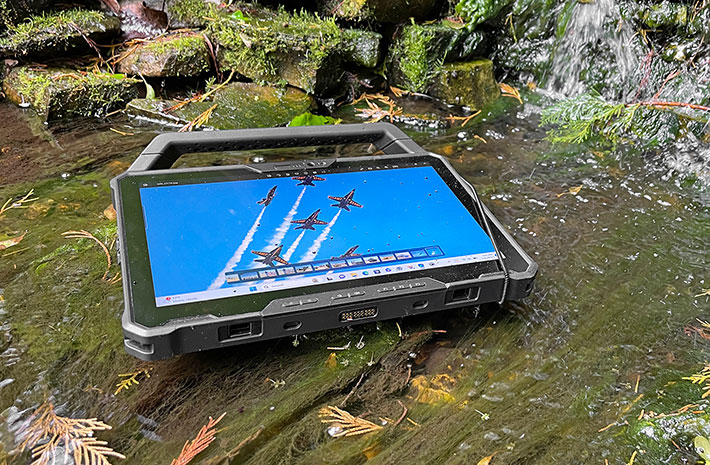
On October 12, 2022, Dell introduced the Latitude 7230 Rugged Extreme Tablet, the fourth generation of the company's fully-rugged 12-inch tablet computer whose origins go back to June 2015. This latest version was launched almost exactly three years after its 7220 predecessor (see our full review). It is a full re-design and a major technology update to the platform. So what's new and what has changed?
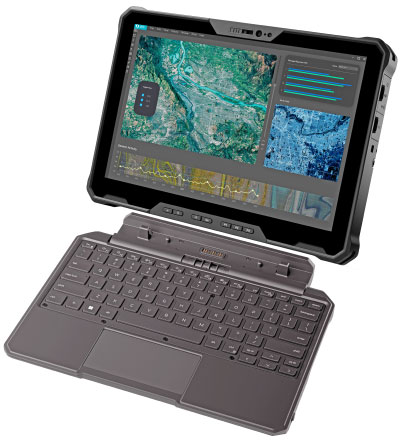 First, there's speed. While Dell's consumer and business laptops are always meticulously kept up-to-date, the same doesn't go for the company's rugged tablets and laptops which often lag behind. To a degree that's understandable since purchase cycles are longer in traditional rugged computer markets such as law enforcement, government, military, industry and such. First, there's speed. While Dell's consumer and business laptops are always meticulously kept up-to-date, the same doesn't go for the company's rugged tablets and laptops which often lag behind. To a degree that's understandable since purchase cycles are longer in traditional rugged computer markets such as law enforcement, government, military, industry and such.
Dell's competition, however, had moved on and so it was high time for Dell to rejuvenate the company's sole rugged tablet platform. And the new 7230 does just that, making a big jump from Intel 8th generation "Whiskey Lake" to Intel 12th generation "Alder Lake" Core processors (see our explanation of Alder Lake).
This put Dell in a good position because at the time of the 7230's launch, other than Durabook's R11, none of the other Tier 1 vendors of fully rugged tablets had upgraded to 12th gen Alder Lake yet. Which made Dell's press release claim of having the most powerful 12-inch fully-rugged tablet plausible.
Dell's latest rugged tablet
While the rugged Dell Latitude tablet is a relative newcomer to Dell's heavy-duty mobile computer lineup, it's actually been around for a good number of years. Initially just called the Dell Latitude 12 Rugged Tablet, the second gen that arrived in 2017 added "Extreme" to its name. And somewhere along the line, Dell dropped the "12" that referred to the tablet's 11.6-inch screen and replaced it with "7220" and now "7230", signifying that they are part of the overall Dell Latitude 7000 Series.
The table below shows the major differences between Dell's original rugged tablet, the 2nd generation "extreme" version, the 7220 model of 2019, and the current 7230 model:
|
Model
|
Rugged Tablet
|
Rugged Tablet 7212
|
Rugged Tablet 7220
|
Rugged Tablet 7230
|
|
Launched
|
June 2015
|
August 2017
|
October 2019
|
October 2022
|
|
CPUs
|
5th gen Intel Core-M
|
6th/7th/8th gen Intel Core
|
8th gen Intel Core
|
12th gen Intel Core
|
|
Display
|
HD 1366 x 768 pixel
|
FHD 1920 x 1080 pixel
|
FHD 1920 x 1080 pixel
|
FHD 1920 x 1200 pixel
|
|
Weight
|
from 3.60 lbs.
|
from 2.80 lbs.
|
from 2.90 lbs.
|
from 2.76 lbs.
|
|
RAM
|
up to 8GB
|
up to 16GB
|
up to 16GB
|
up to 32GB
|
|
mSATA storage
|
up to 500GB
|
up to 1TB SATA
|
NA
|
NA
|
|
PCIe NVMe storage
|
NA
|
up to 1TB
|
up to 2TB PCIe
|
up to 2TB PCIe
|
|
Power
|
2 x 26Wh
|
2 x 26Wh or 2 x 34Wh
|
2 x 34Wh
|
2 x 35.6Wh
|
|
Battery Life
|
Up to 12 hours
|
Up to 19 hours
|
Unknown
|
Unknown
|
|
USB
|
USB 3.0
|
USB 3.0 + USB 3.1 Type-C
|
USB 3.0 + USB 3.1 Type-C
|
2 x TB4 + USB 3.2 Type-A
|
|
Handle
|
Soft
|
Soft or hard
|
Soft or hard
|
Soft or hard
|
|
Kickstand
|
fixed angle
|
variable angle (180°)
|
variable angle (180°)
|
variable angle (180°)
|
The original tablet came with 4.5-watt Intel 5th generation Core-M processors. Those turned out to be a bit underpowered, and so Dell switched to more powerful Intel 6th, 7th and 8th generation 15-watt full Core processors with their second tablet generation. 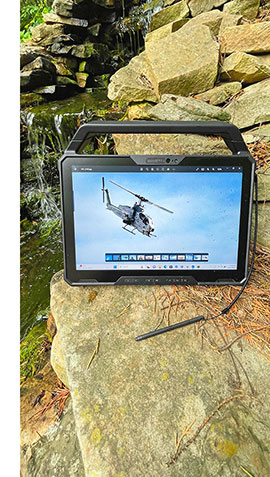 Dell continued to offer 6th gen processors because those were the last to still support Windows 7, and 7th gen processors because at the time of the 2nd gen's introduction, Intel's 8th gen was still brand-now. The 2019 7220 model switched to all 8th generation CPUs. Dell continued to offer 6th gen processors because those were the last to still support Windows 7, and 7th gen processors because at the time of the 2nd gen's introduction, Intel's 8th gen was still brand-now. The 2019 7220 model switched to all 8th generation CPUs.
And now the new Latitude 7230 Rugged Extreme Tablet jumped all the way to the 12th generation of Intel Core processors. Ancillary technology has been upgraded as well, with newer, more economical, and much faster LPDDR5 RAM, and twice the maximum RAM (32GB vs 16GB) available. Mass storage was already of the super-quick PCIe NVMe variety in the last generation of the tablet, so not much has changed there.
Wi-Fi now is of the newest Wi-Fi 6E kind that's not only much quicker, but also provides access to a third band at 6GHz. Bluetooth is at the 5.2 or 5.3 level depending on whether customers opt for Intel or Qualcomm Wi-Fi. Mobile broadband remains at Qualcomm X20 (4G/LTE) or X55 (5G), each with either physical or eSIM. GNSS is via a uBlox NEO-M9N module, a minor upgrade over the NEO-M8 in the 7220.
Weight always matters in tablets, and here Dell claims that with a starting weight of just 2.78 pounds the 7230 is the lightest of all 12-inch fully rugged tablets. That may well be so, as even Zebra's slender ET80/85 tablet weighs in at 2.80 pounds.
The 7230 does have a new display, one that grew from 11.6 to 12.0 inches diagonally. Resolution went from the 16:9 1920 x 1080 to a 16:10 1920 x 1200 pixels, and at 1200 nits luminance the new screen is 200 nits brighter than the old one. Win-win on that front, though we're hoping to soon see higher resolution yet in these high-performance tablets (like the Zebra ET80/85's 2160 x 1440 or better).
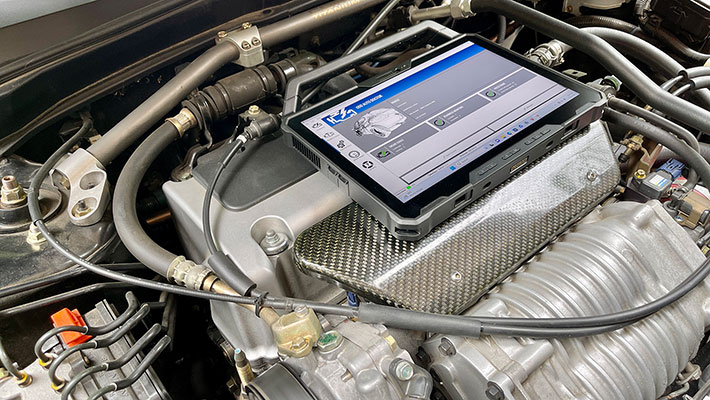
Flexible connectivity is crucial in enterprise and field deployments, and it's an area where most consumer tablets are lacking. Addressing that is not an easy task given the large number of possible connectivity requirements that may include legacy I/O such as serial or older card formats, especially while still living within the physical constraints of a compact and lightweight tablet.
In light of that, and looking forward, Dell added dual Thunderbolt 4 ports to carry most of the general purpose connectivity load on the new 7230. There's still a USB 3.2 Type-A port for when you don't have a cable with a USB Type-C connector handy. Whatever else you might need comes as options in two expansion I/O areas. On the side you can opt for HDMI 2.0 or another USB Type-A port. In the back you may opt for RJ45, mini-serial, a 1D/2D barcode scanner or a waterproof Fischer screw-on port.
What does Thunderbolt 4 bring to the table? Thunderbolt started as a joint effort between Intel and Apple for a faster and more powerful data transfer interface. It then evolved to use the popular reversible USB Type-C connector, combining all the goodness of the PCIe and DisplayPort interfaces, and also supporting the super-fast USB 4 standard with upstream and downstream power delivery capability. So with Thunderbolt 4 you need just one USB 4 cable and a Thunderbolt 4 dock to connect all at once to keyboards, mice, external drives, two external 4k displays as well as charging the tablet itself (Dell offers 65 and 90 watt USB-C chargers for the 7230). It can get a bit confusing between TB4 and all those USB plugs and versions, but it's a good step forward.
Design, look, and feel
All of Dell's Rugged and Rugged Extreme laptops and tablets are part of the company's Latitude line of business laptops and can be viewed at the Latitude Rugged laptops and tablets section. Going to dell.com/rugged gets you to the same place. To shop for Dell rugged models, go here. It's a bit confusing and we wish Dell would be clearer as to where the rugged lineup is and what part of the company it belongs to.
Even though all of Dell's rugged laptops and tablets are part of the "Latitude" line, that doesn't mean they are simply heavier-duty and better protected versions of standard Dell Latitude products. Instead, while the rugged products may share certain components and technologies from certain models in the Latitude lineup, they are unique and separate designs from the ground up. While "civilian" business Latitudes sport a sleek, elegant contemporary consumer/business laptop look, the rugged models use an entirely different design language.
As is, Dell has done a good job in visually differentiating their rugged offerings from more civilian and enterprise platforms, all the while creating a sharp, purposeful and quite elegant design. It's a style that's not as overtly utilitarian as some competing rugged computing gear; Dell went more for an elegant, high quality look. The tablet feels tough, solid and substantial, and there's never a doubt that this is a much heavier-duty computing device than any standard consumer or even business tablet.
But let's take a closer look at the Dell Latitude 7230 Rugged Extreme Tablet. Below you can see the top and all four sides of the machine:
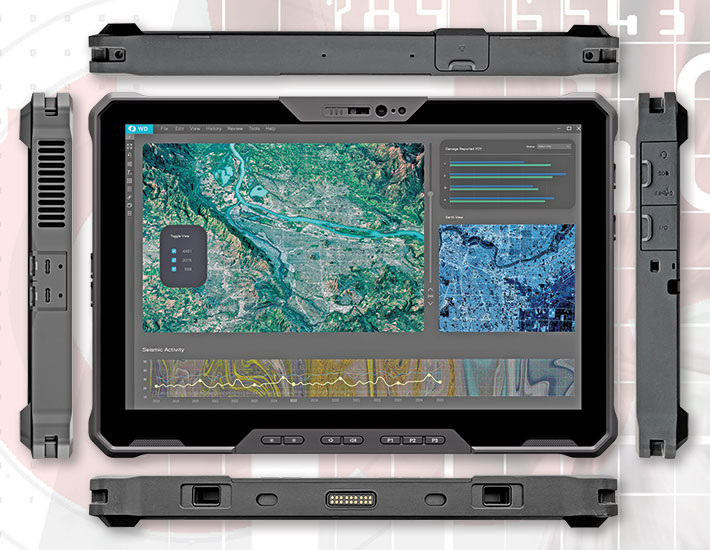
Dell's using just one color here, black. The housing is black reinforced polycarbonate plastic, with the front bezel and sides having a matte, rubberized finish. There are protective corner bumpers that are nicely integrated into the overall design. Since the tablet has a capacitive touch screen, the front glass extends flush well beyond the actual LCD perimeter, just as it should for comfortable touch operation. And the actual housing bezel surrounding the glass slightly angles up, so as to provide extra protection to the screen without having your fingers bump into it. The glass surface itself is glossy but in a heavily muted way.
Below the display, which is clearly designed to be used in landscape orientation, are seven physical buttons. The layout now also includes brightness up/down buttons that were missing in earlier versions, a very valuable addition in a tablet. All labels are very legible. The front camera is in the center where it belongs, and it has a manual shutter.
Ports and connectivity are both on the left and the right side of the tablet. To guard against physical damage, all ports are located behind protective doors that snap into place. The picture below shows, on top, the right side of the unit with all protective doors removed for a better view at the ports. From left to right there's the slot for the tethered stylus, a wedge-shaped physical lock-slot, then an optional I/O position that can be used for an HDMI 2.0 port (as shown) or a USB 3.2 Gen 1 Type-A port, next to that a USB 3.2 Gen 1 port with PowerShare, below that a microSD-card slot, and then a headset (headphone and microphone combo) port.
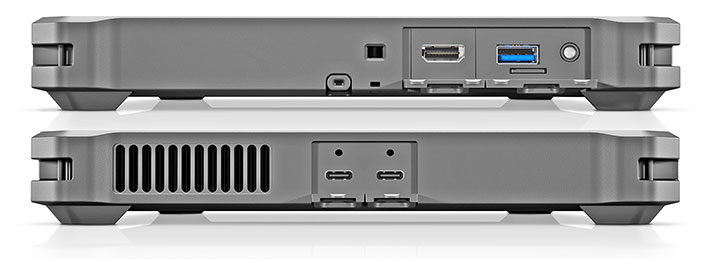
The left side of the 7230 shows, from left to right, the fan exhaust grill and then two Thunderbolt 4 ports with DisplayPort Alt Mode, USB4 standard data transfer, and upstream/downstram power delivery.
Overall, the design of the Dell Latitude 7230 Rugged Extreme Tablet is impressive, merging ruggedness and functionality into an elegant, business-like tool for the job. It is an elegant, practical, functional solution that looks and feels just right.
Capacitive multi-touch — works with gloves
The Dell Latitude 7230 Rugged Extreme Tablet, like virtually every other modern tablet, offers 10-point capacitive multi-touch. Tapping, panning, swiping, pinching and zooming work smoothly and effortlessly with none of the slight delay that used to bedevil touch on Windows hardware.
The capacitive touch screen of the Rugged Tablet also handles gloves quite well. The tablet display surface is as smooth as we've come to expect from capacitive touch technology.
 The tablet comes with a 4-inch capacitive stylus. Dell has been experimenting with different types of styli over the years. The 7212 had a narrow 3mm hard rubber tip, the 7220 a hard 6mm tip, and this latest one has a slightly narrower hard 5mm tip. The stylus provides a pencil-like sensation and even sound, but we had to get used to a stylus with such a thick tip. When not in use, the stylus, which has an almost foot-long spiral tether cord, can be parked in a special garage on top of the tablet. The tablet comes with a 4-inch capacitive stylus. Dell has been experimenting with different types of styli over the years. The 7212 had a narrow 3mm hard rubber tip, the 7220 a hard 6mm tip, and this latest one has a slightly narrower hard 5mm tip. The stylus provides a pencil-like sensation and even sound, but we had to get used to a stylus with such a thick tip. When not in use, the stylus, which has an almost foot-long spiral tether cord, can be parked in a special garage on top of the tablet.
Note that Dell offers an active pen option, though we're not sure what active technology Dell is using with it. The tablet's capacitive multi-touch was fast and precise enough for most tablet operations, though we also often used the stylus.
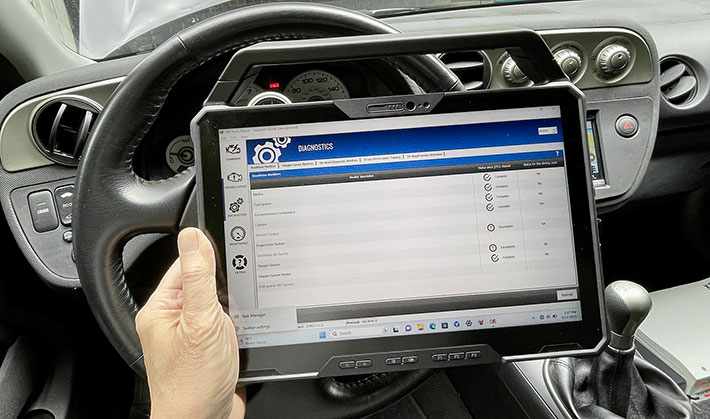
Intel 12th gen "Alder Lake" power
As stated above, Dell's rugged tablet platform had fallen behind the competition in terms of technology and performance, and it was high time for an upgrade. And the new 7230 does just that, making a big leap from Intel's 8th generation chips to 12th generation "Alder Lake" Core processors.
Alder Lake is more than just a newer Intel chip generation. It is Intel's first major "hybrid" processor design, combining large, powerful performance cores ("p-cores") and smaller, simpler economy cores ("e-cores"). Why using two types? Because it's not power-efficient to use high-performance cores for simple routine or background work. Smartphones, both on the iPhone and the Android side, have been using different cores for different work for years.
So what "Alder Lake" brings is combinations of p-cores and e-cores. On the p-core side Intel is using a new high-end microarchitecture called Golden Cove. 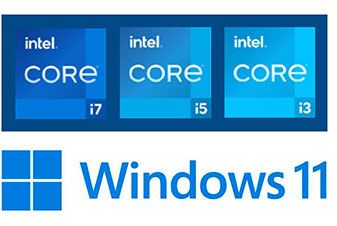 On the e-core side, which is basically Intel Atom processor technology, there's also a new microarchitecture named Gracemont. According to Intel, each Gracemont e-core is capable of as much or more performance than one of Intel's 6th generation "Skylake" cores, at much lower power consumption. How does this mix of p-cores and e-cores work? The idea is to route heavy-duty, time-critical work to the p-cores and simpler tasks of lesser importance to e-cores. To do that, Intel and Microsoft worked together on "Thread Director," a technology that examines work and decides what goes to which type of core. Only Windows 11 includes full thread director capabilities, which is why Windows 11 comes standard with the 7230 (a Windows 10 downgrade is available). On the e-core side, which is basically Intel Atom processor technology, there's also a new microarchitecture named Gracemont. According to Intel, each Gracemont e-core is capable of as much or more performance than one of Intel's 6th generation "Skylake" cores, at much lower power consumption. How does this mix of p-cores and e-cores work? The idea is to route heavy-duty, time-critical work to the p-cores and simpler tasks of lesser importance to e-cores. To do that, Intel and Microsoft worked together on "Thread Director," a technology that examines work and decides what goes to which type of core. Only Windows 11 includes full thread director capabilities, which is why Windows 11 comes standard with the 7230 (a Windows 10 downgrade is available).
How all of this thread directing works goes well beyond the scope of this review. But I hope the above explanation shows the reason for going from a (Intel 8th generation) quad-core processor with eight threads like the last version of Dell's rugged tablet had, to a hybrid CPU with two power cores that each have two threads, and then eight economy cores, for a total of 12 threads.
The table below shows the three processors available for the Dell Latitude 7230 Rugged Extreme Tablet, with their major specs (see the full table here):
|
|
CPU Options
|
Intel
|
Intel
|
Intel
|
|
|
Intel
|
Core i7-1260U
|
Core i5-1240U
|
Core i3-1210U
|
|
|
Codename
|
Alder Lake
|
Alder Lake
|
Alder Lake
|
|
|
Performance Cores
|
2 cores/4 threads
|
2 cores/4 threads
|
2 cores
|
|
|
Efficiency Cores
|
8
|
8
|
4
|
|
|
Total threads
|
12
|
12
|
10
|
|
|
Max Turbo Speed
|
3.50/4.70 GHz
|
3.30/4.40 GHz
|
3.30/4.40 GHz
|
|
|
Thermal Design Power (TDP)
|
9/29 watts
|
9/29 watts
|
9/29 watts
|
|
|
Smart Cache
|
12MB
|
12MB
|
4MB
|
|
|
Integrated graphics
|
Intel Iris Xe
|
Intel Iris Xe
|
Intel UHD Graphics
|
|
|
Graphics max speed
|
900 MHz
|
900 MHz
|
850 MHz
|
|
|
Graphics EUs
|
96
|
80
|
64
|
|
|
Intel vPro
|
Yes
|
Yes
|
No
|
|
|
Intel SIPP
|
Yes
|
Yes
|
No
|
|
|
Intel Trusted Execution
|
Yes
|
Yes
|
No
|
Dell offers one each of the i3 ("good"), i5 ("better") and i7 ("best") versions of Intel's 12th generation "Alder Lake" processors. At first sight, there seems to be less performance difference between available processors than we've seen in the past. All three CPU options have two performance cores, all are 9/29 watt designs, and even the i3 chip now comes with turbo boost.
At the low end is the Core i3-1210U with two performance cores, each having two threads, and four efficiency cores. That makes for a total of eight processing threads. The efficiency and performance cores max out at 3.30 and 4.40 GHz, respectively, there's 10MB of Intel Smart Cache, there's no vPro, and the i3-1210U only supports Intel UHD Graphics on 64 execution units.
Available for about $150 more is the mid-range Core i3-1240U with two performance cores, each with two threads, and eight efficiency cores. That makes for a total of 12 processing threads. The efficiency and performance cores max out at 3.30 and 4.40 GHz, respectively, just like the i3 chip, but there's 12MB of Intel Smart Cache, vPro support, and the i5-1240U supports the more powerful Intel Iris Xe Graphics on 80 execution units.
For another $190 you get the top-of-the-line Core i7-1260U, also with two performance cores, eight efficiency cores, 12 processing threads, 12MB of Intel Smart Cache and vPro support. Here, the efficiency and performance cores max out at slightly higher 3.50 and 4.70 GHz, respectively, but the i7-1260U runs Intel Iris Xe Graphics on 96 execution units.
Customers may rightfully ask themselves whether just two performance cores plus a number of economy cores are better than the full four performance cores of the predecessor 7220.
That question is addressed in the benchmark table below, where we are comparing the performance of the 7230 to the predecessor 7220 and also to Dell's competition from other industry leaders that also offer 12-inch rugged tablets.
|
Dell 7230 vs 12-inch class rugged tablets
|
|
Company
|
Dell
|
Dell
|
Durabook
|
Durabook
|
Getac
|
Getac
|
Zebra
|
|
Model
|
7230
|
7220
|
R11
|
U11
|
F110
|
K120
|
ET85
|
|
Introduced
|
2022
|
2018
|
2022
|
2022
|
2021
|
2021
|
2022
|
|
CPU model
|
i5-1240U
|
i7-8665U
|
i7-1255U
|
i5-10201Y
|
i7-1165G7
|
i7-1165G7
|
i5-1130G7
|
|
CPU code
|
Alder Lake
|
Whiskey Lake
|
Alder Lake
|
Comet Lake
|
Tiger Lake
|
Tiger Lake
|
Tiger Lake
|
|
TDP
|
9/29 watts
|
15 watts
|
12/55 watts
|
5.5/9 watts
|
12/28 watts
|
12/28 watts
|
7/15 watts
|
|
Display size
|
12.0-inch
|
11.6-inch
|
11.6-inch
|
11.6-inch
|
11.6-inch
|
12.5-inch
|
12.0-inch
|
|
Resolution
|
1920 x 1200
|
1920 x 1080
|
1920 x 1080
|
1920 x 1080
|
1920 x 1080
|
1920 x 1080
|
2160 x 1440
|
|
Luminance
|
1337 nits
|
1018 nits
|
1246 nits
|
1204 nits
|
950 nits
|
1115 nits
|
706 nits
|
|
Footprint
|
11.65 x 8.00
|
12.30 x 8.00
|
11.80 x 7.60
|
12.50 x 8.00
|
12.40 x 8.15
|
13.0 x 9.40
|
12.10 x 8.90
|
|
Thickness
|
0.94
|
0.96
|
0.78
|
0.94
|
0.98
|
0.94
|
0.6
|
|
Volume (cu-in)
|
87.6
|
94.5
|
69.9
|
94.0
|
99.9
|
114.9
|
64.6
|
|
Weight (lbs.)
|
2.76
|
2.90
|
2.73
|
3.00
|
3.35
|
3.75
|
2.80
|
|
Operating temp
|
-20° to 145° F
|
-20° to 145° F
|
-6° to 122° F
|
-20° to 145° F
|
-20° to 145° F
|
-20° to 145° F
|
-4° to 140° F
|
|
IP rating
|
IP65
|
IP65
|
IP66
|
IP66
|
IP66
|
IP66
|
IP65
|
|
PassMark 6.1
|
8,364
|
5,979
|
11,001
|
2,504
|
6,382
|
6,585
|
5,534
|
|
PassMark 9.0
|
5,516
|
3,960
|
5,602
|
2,467
|
5,634
|
5,839
|
4,120
|
|
CrystalMark
|
401,322
|
332,183
|
417,117
|
197,684
|
535,124
|
522,217
|
317,931
|
|
PCMark 10
|
4,847
|
NA
|
5,359
|
NA
|
5,020
|
5,148
|
3,855
|
|
3DMark TimeSpy
|
1,142
|
NA
|
1,384
|
NA
|
1,314
|
1,434
|
888
|
|
GeekBench 5 S
|
1,496
|
NA
|
1,586
|
NA
|
1,480
|
1,531
|
1,291
|
|
GeekBench 5 M
|
7,049
|
NA
|
5,747
|
NA
|
4,690
|
4,831
|
3,136
|
As always, the results in the above table should not be construed as an absolute comparison of which product is fastest. Each of the listed devices comes/came with several processor options, and products may have been upgraded since we last benchmarked them in the RuggedPCReview.com testing lab. So view the numbers as what sort of performance can be expected from different types of processors and processor generations, clock speeds, and thermal design powers.
What is immediately clear is that this latest implementation of Dell's rugged tablet is indeed faster than its 7220 predecessor, perhaps by not quite as much as we had hoped, but still substantially faster than the Intel 8th generation-based 7220 tablet we tested three years ago.
Compared to the primary competition from Getac and Durabook, the situation is less clear. The also Alder Lake-based Durabook R11 is quicker in most benchmarks even though it's a fanless unit operating within thermal limits, but its i7-1255U is a higher class chip than the i5-1240U in our review 7230. Getac's F110 and K120 models, both based on Intel 11th generation technology overall beat the 7230, though results may be different with the 7230's Core i7 option. Zebra's Intel 11th gen ET85 tablet lags behind, but it's a more enterprise-oriented design that is not a direct competitor to the Dell 7230.
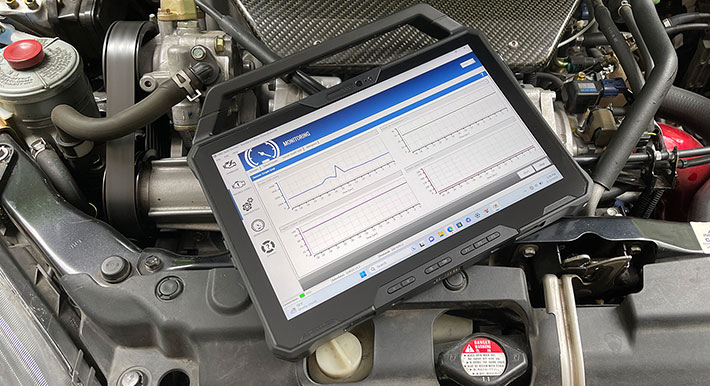
What it boils down to is that Dell's rugged 12-inch tablet is now technologically up-to-date and a substantially faster machine than its predecessor that has fallen behind the times. As for Intel's new "Alder Lake" hybrid processor architecture, it's still new and its full potential may not have been reached just yet. As time goes on we will likely see fine-tuning for Alder Lake both via systems configuration and via the Windows 11 Thread Director.
I should mention that benchmark performance of the 7320 is significantly higher when plugged in than it is when the system is run on battery power. Depending on the benchmark, AC/DC performance can be 20-40% higher than battery performance. Intel dynamic tuning technology gives manufacturers to the option to configure their products with different running modes. Dell appears to have configured the 7230 for maximum performance when plugged in, and maximum operation time when running on battery
Battery life
The 10 hour-plus battery life of iPad-class consumer tablets has customers expect full-shift battery life from their ruggedized Windows tablets as well. Improving power conservation measures by Intel and Microsoft, (slowly) improving battery technologies, and computer manufacturers' experience combine to give modern Windows tablets higher performance and longer battery life. Is the Latitude 7230 one of them?
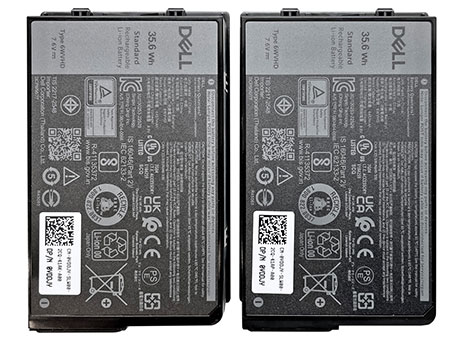 First a few words about the power situation of Dell's rugged tablet. The 7230 has two battery bays each accommodating a 35.6 watt-hour Lithium-Ion battery, for a total of 71.2 watt-hours. That's impressive for a lightweight high-performance tablet, and a 5% increase over the 7220 predecessor's capacity. First a few words about the power situation of Dell's rugged tablet. The 7230 has two battery bays each accommodating a 35.6 watt-hour Lithium-Ion battery, for a total of 71.2 watt-hours. That's impressive for a lightweight high-performance tablet, and a 5% increase over the 7220 predecessor's capacity.
The dual battery system means users can hot-swap one battery for a freshly-charged one at a time. Dell doesn't list expected battery life in the 7230 specs. For the predecessor 7220 they claimed up to 19 hours of battery life from systems with two 34 watt-hour batteries. What can one expect from the 7230 equipped with two batteries? To find out we tested power draw with PassMark's BatMon utility.
|
Dell Latitude 7230 Rugged Extreme Power Draws (at idle)
|
|
Backlight level
|
Lowest (0%)
|
50%
|
Maximum (100%)
|
|
Power Saver
|
3.6 watts (19.8 hrs)
|
3.7 watts (17.0 hrs)
|
10.1 watts (7.0 hrs)
|
|
Max Performance
|
3.7 watts (19.2 hrs)
|
4.2 watts (16.9 hrs)
|
10.5 watts (6.8 hrs)
|
With Windows set to "Power Saver" and screen brightness at its dimmest (which is very dim), we saw a power draw as low as 3.6 watts, good for a theoretical 19.8 hours. With the backlight at 50%, we saw 3.7 watts, good for a theoretical 17 hours. And with the backlight all the way up, power draw rose considerably to 10.1 watts, good for a theoretical 7 hours.
With Windows set to "Max Performance" and screen brightness at its dimmest, we saw a power draw as low as 3.7 watts, good for a theoretical 19.2 hours. With the backlight at 50%, we saw 4.2 watts, good for a theoretical 16.9 hours. And with the backlight all the way up, power draw rose to 10.5 watts, bringing theoretical battery life down to 6.8 hours.
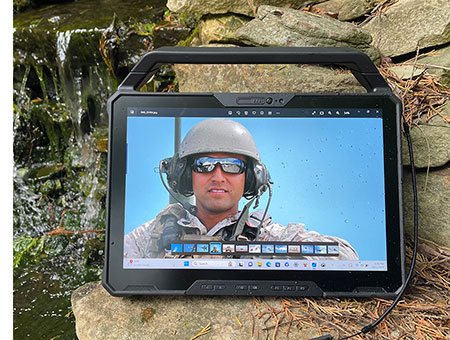 Overall, the new Latitude 7230 Rugged Extreme Tablet wasn't quite as power-efficient as the old Intel 8th generation-powered 7220 we tested three years ago. The minimum observed draw of 3.6 watts of our mid-level Core i5-1240U test machine was 0.8 watts higher than what we observed on the prior generation tablet, and maximum power draw was a bit higher as well. Overall, the new Latitude 7230 Rugged Extreme Tablet wasn't quite as power-efficient as the old Intel 8th generation-powered 7220 we tested three years ago. The minimum observed draw of 3.6 watts of our mid-level Core i5-1240U test machine was 0.8 watts higher than what we observed on the prior generation tablet, and maximum power draw was a bit higher as well.
In actual real-world use it comes, of course, down to how the tablet is used, what power conservation modes are selected, and what settings are activated.
As is, the Dell Latitude 7230 Rugged Extreme did meet the 19 hours Dell claim in the BatMon drawdown test, but in the PCMark 10 full battery test, it only lasted 11:51 hours. That's still more than a full shift.
A look inside
If you open up an iPad or an Android consumer tablet, you'll find a big flat battery and a tiny hyper-integrated circuitboard inside, and not much else. Rugged Windows tablets look very different inside, because there is a full PC squeezed into a compact box. Some parts may be miniaturized, but it's still roughly the same that you'd find inside a PC, with standard connectors, components and modules. And that's no different inside the Latitude 7230 Rugged Extreme Tablet.
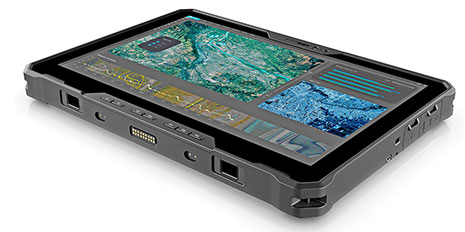 A big challenge for rugged Windows tablet makers is the creation of a package that not only accommodates a whole PC with all of its ports, but one that won't let dust and liquids get inside. A big challenge for rugged Windows tablet makers is the creation of a package that not only accommodates a whole PC with all of its ports, but one that won't let dust and liquids get inside.
And the package must be designed and built so things don't break or come loose when the device is dropped and rattled around. How did Dell meet that challenge?
Given the company's status as one of the world's largest laptop makers, you'd think they'd simply start with one of their consumer or enterprise and put that into a tougher, better sealed housing.
Or, since the 7230 isn't the first rugged Dell tablet, that they simply updated the predecessor 7220. Neither is the case. We compared the insides of the 7230 to those of its predecessor and they are completely different. The 7230 is an entirely new design.
So let's take a closer look. Unlike most Windows laptops and many tablets, the Latitude 7230 Rugged Extreme Tablet doesn't have multiple removable covers on its back to provide access to RAM memory and internal expansion slots. So if you want to replace one of the PCIe modules (RAM, unfortunately, is soldered and cannot be added to or replaced), or if maintenance becomes necessary, you have to open up the tablet.
That's fairly easy. Undo a couple of dozen small Philips screws and the halves come apart. There are, however, two ribbon cables with fragile connectors between the halves. These connectors have to be carefully unplugged.
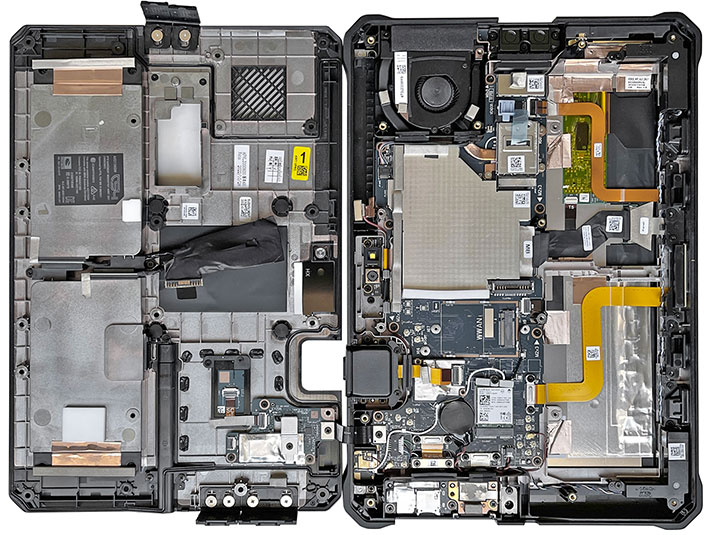
The seal between the back and the front part of the housing — both made of impact-resistant, flame-retardant, glass fiber-reinforced PC-GF20FR(40) polycarbonate — is a hard plastic lip on the backside that presses onto a thin black (in designs like that, we like to see the seal in a contrasting color; that makes it much easier to examine it for damage) rubber o-ring seal sitting in a channel on the front side. The o-ring seal is long and complex but seems replaceable. What's interesting here is that the seal doesn't just go along the perimeter of the tablet. Instead, it weaves in and out, protecting the electronics inside, but leaving anything I/O-related outside.
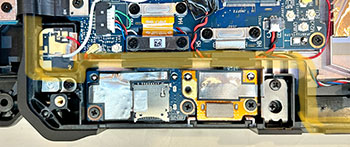 That's because it is not easy to properly seal standard PC ports and connectors. In most rugged devices those ports are not actually sealed to the inside. Instead, rubber plugs and hinged doors provide the protection. If one of them isn't closed properly, liquids can enter the inside of such devices. With Dell's design, it can't. Note the yellow highlight in the image to the right. That's how the seal keeps liquids outside even if a port should fail or forgotten to be closed. That's because it is not easy to properly seal standard PC ports and connectors. In most rugged devices those ports are not actually sealed to the inside. Instead, rubber plugs and hinged doors provide the protection. If one of them isn't closed properly, liquids can enter the inside of such devices. With Dell's design, it can't. Note the yellow highlight in the image to the right. That's how the seal keeps liquids outside even if a port should fail or forgotten to be closed.
Doing it this way is more complex, but potential damage is limited to an I/O module and not the entire tablet. And I say "potential" damage, because Dell actually applies what they call HZO liquid protection and describe as a "nanotechnology solution that inoculates electronic components from damage and failure." An additional advantage of separating I/O modules from the motherboard is that this makes it much easier to upgrade and/or customize I/O. No need to redesign the motherboard.
Even though the internal layout of the Latitude 7230 Rugged Extreme Tablet is complex, components such as WiFi (ours had an Intel Model AX211NGW half-card), PCIe NVMe SSD mass storage, GPS (NEO-M9N), and other wireless modules, as well as the various antenna blocks, are easily accessible once the tablet has been opened.
The modularity, of course, is in Dell's DNA, the result of decades of offering an almost infinite number of permutations of options available right on Dell's website. So almost any feature for which there might be alternatives — or of which a customer might want more or less of — is not on the motherboard but designed as modules.
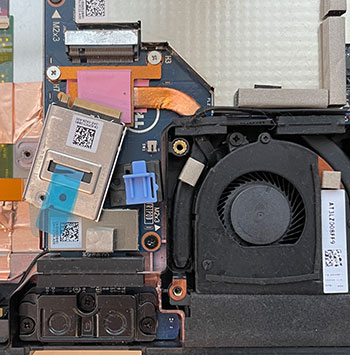 One thing that's immediately obvious is the Latitude 7230 Rugged Extreme Tablet's thermal management. That includes a small but powerful fan with a heavy metal enclosure that, of course, is sealed towards the interior of the device. Copper pipes conduct heat away from the processor, ancillary electronics, and also the PCIe-based SSD. One thing that's immediately obvious is the Latitude 7230 Rugged Extreme Tablet's thermal management. That includes a small but powerful fan with a heavy metal enclosure that, of course, is sealed towards the interior of the device. Copper pipes conduct heat away from the processor, ancillary electronics, and also the PCIe-based SSD.
And note how little space storage takes today! The super-fast 512GB (up to 2TB optional) PCIe NVMe storage module measure less than an inch square. Compare that to the old rotating hard drives and optical disc bays.
Interestingly, the initial Dell Rugged Tablet that launched in 2015 only had a tiny and nearly invisible fan and no heat pipes. Why the change to beefier thermal management? That's because the original tablet's relatively low-performance processor had a Thermal Design Power (a measure of CPU performance) rating of just 4.5 watt whereas the one in this tablet is 9 watt design that can go up to as high as 29 watts.
But aren't the three processors available for the 7320 is still considered "ultra-low voltage" by Intel? And aren't all ultra-low voltage processors supposed to be able to operate without potentially noisy and troublesome fans in Windows tablets?
Only under certain circumstances. That's because years ago Intel's ultra-low voltage processor did not have a "turbo" mode that allows CPUs to briefly run much quicker than their nominal clock frequency, as long as temperatures don't exceed certain levels.
Turbo mode is great, but it can turn into a problem in rugged machines. When a machine gets too hot out there in the desert and there is no active cooling, performance will drop, and can drop to unacceptable levels. That's why Dell chose to go with a fan in the Latitude 7230 Rugged Extreme Tablet. This way, performance will not drop due to overheating, no matter what.
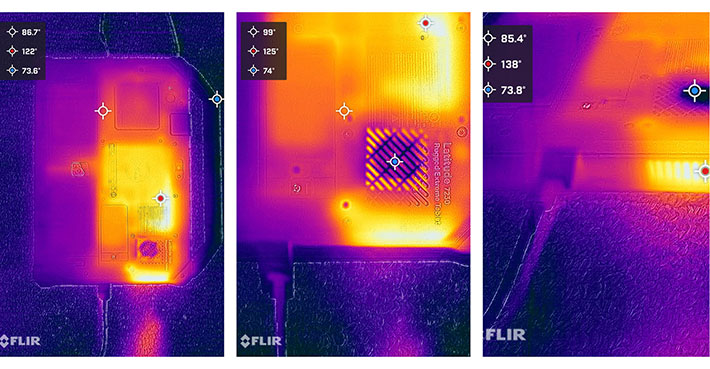
The pictures above show the Dell Rugged Extreme Tablet's thermal engineering, taken with our FLIR One Pro infrared camera during a strenuous PCMark 10 performance test benchmark run.
The bright yellow areas are the hottest, and that is where the heat is conducted away from electronics via the system's thermal pipes. On the left you can see 7230's backside with the electronics area reaching 122F, in the middle a close-up of the fan sucking in cool 74F air, and on the right you can see the fan expelling 138F exhaust air. This is all a little hotter than what we saw in the predecessor 7220, probably due to the much higher maximum TDP of the new processor.
Overall, the interior of the Dell Latitude 7230 Rugged Extreme Tablet is a complex, sophisticated affair that very much shows Dell's experience in mobile computing technology. Components and modules are clearly marked and have their own 2D scan code. Wires that go from modules to their respective antennae located around the perimeter of the tablet for best reception are guided and held in place with little loops and guides.
Excellent display
The Latitude 7230 Rugged Extreme Tablet has a display that measures 12.0 inches diagonally. It offers 1920 x 1200 pixel resolution, which makes for a 16:10 wide format aspect ratio and 189 ppi (pixels per inch). That's a big step up from of the original Latitude 12 Rugged Tablet that came with 1366 x 768 pixel resolution and only 135 ppi. And also a small step up (13% more active screen area) from the 7220 which had an 11.6-inch screen with 1920 x 1080 pixel resolution. Even 189 ppi dpi is not terribly sharp by today's leading smartphone and tablet standards, but it looks nice and crisp and is also the same as what most of the direct competition offers (Zebra offers more with 2160 x 1440 pixels).
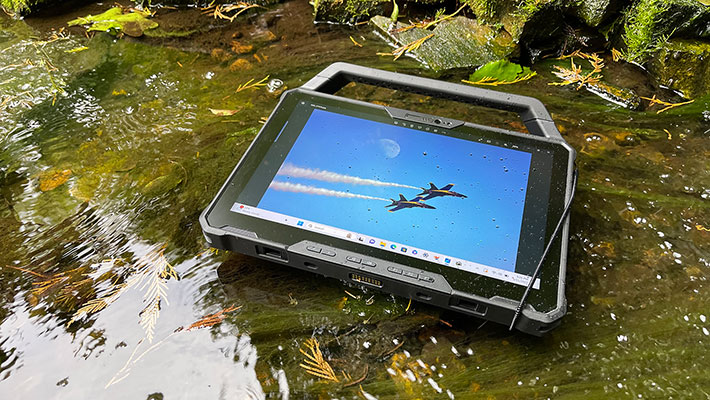
But, regardless of size or sharpness, providing the right display for a system that's being used outdoors is much more difficult than for one that's mostly used indoors in an office or at home. That's because we now have incredibly sharp, photorealistic-grade displays for indoor use, displays that one can't imagine getting much better. But outdoors is a totally different story.
That's because a) it's much brighter outdoors, with even the brightest display not being a match for sunlight, and b) because there are all sorts of reflections that can quickly make a display unreadable.
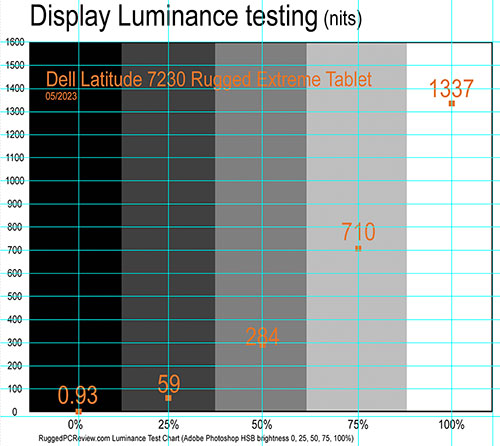 With regard to LCD outdoor viewability, Dell was a pioneer. As far back as 2007, Dell had laptop displays that had their screen cover optically bonded to the LCD, and display layers also bonded directly, thus eliminating the number of reflecting surfaces, eliminating the need to AR-coat the bottom of the screen cover, and eliminating any air gaps. With regard to LCD outdoor viewability, Dell was a pioneer. As far back as 2007, Dell had laptop displays that had their screen cover optically bonded to the LCD, and display layers also bonded directly, thus eliminating the number of reflecting surfaces, eliminating the need to AR-coat the bottom of the screen cover, and eliminating any air gaps.
The methods Dell applied reduced overall reflectivity and resulted in a very good effective contrast ratio. At the time, we termed it "definitely readable in sunlight." That was rare back then.
Time doesn't stand still though, and good outdoor-viewable displays are now available from all of the major rugged laptop vendors. Some are offering very high screen brightness of up to 1,500 nits, and optical treatments are continually refined. In the past, Dell favored advanced optical treatments that concentrated on reducing reflected light as opposed to using battery-draining super-bright backlights. That made for impressive outdoor viewability even without a strong backlight — a Dell rugged tablet we tested in 2017 offered 560 nits luminance and still provided good outdoor viewability.
560 nits was nice and bright back then, but Dell decided to amp up brightness in more recent models. The Latitude 7220 we tested in 2019 clocked in at a measured 1,020 nits. And the new Latitude 7230, rated at 1200 nits, scored a very impressive 1337 in our testing, the highest we've seen in this class.
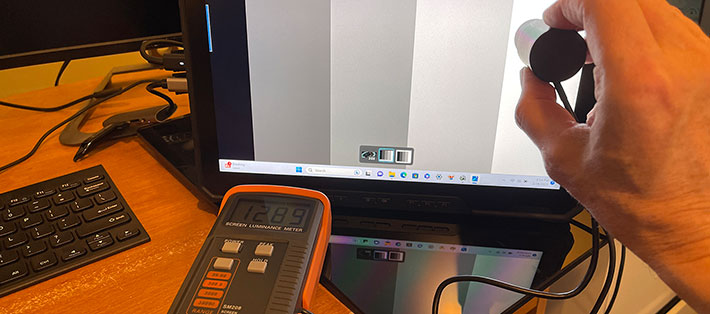
The image below shows the 7230 outdoors with, from left to right, first looking straight at the display, then angling it slightly so that the sky now reflects on the upper half of the display, and then angling it more so that the sky is reflecting on the full display.

Note the total absence of reflections on the left-most picture. That's a big plus of the 7230's semi-matte display compared to the glossy displays that virtually all smartphones and consumer tablets and most rugged tablets have. 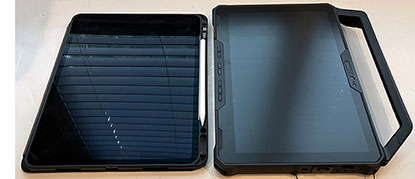 There is, however, always a tradeoff with current technology displays. In this case, the semi-matte display diffuses light instead of reflecting it back, as a glossy display would. We've all learned to live with current display technology on our devices, holding them so that reflection is minimized. There is, however, always a tradeoff with current technology displays. In this case, the semi-matte display diffuses light instead of reflecting it back, as a glossy display would. We've all learned to live with current display technology on our devices, holding them so that reflection is minimized.
To the right, a comparison between a 12.9-inch iPad Pro and the Dell 7230 illustrates the difference between a glossy and a semi-matte display. The iPad reflects mirror-like, whereas the Dell mutes the reflections, which makes them much less distracting. Dell's semi-matte display solution actually works better outside that a fully glossy displays.
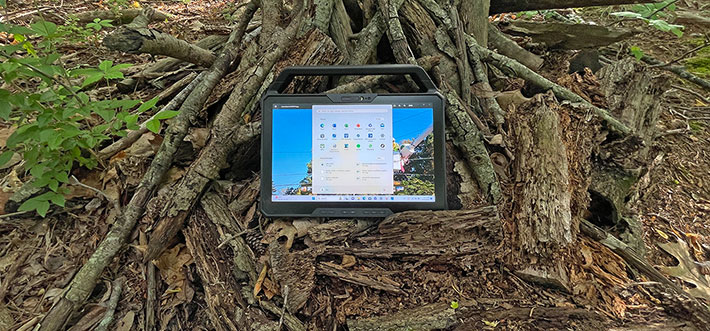
Exemplary tablet control interface
Tablets fail or succeed by not only the ease at which they can be used and controlled, but also by tablet-optimized software, apps and utilities. That's especially important in the Windows world which, despite progress made with Windows 10 and 11, is deeply rooted in decades' worth of the desktop/keyboard/mouse paradigm.
Dell knows that and that's the reason why their tablet has a number of physical control buttons to quickly adjust volume and screen brightness, and perform frequently used tasks with three programmable function keys. Thank you, Dell!

While the buttons help augment the tablet experience on the hardware side, Dell's also addressing matters on the software side. That's where the "Rugged Control Center" app comes in. It includes a dashboard that can be populated with one-touch hardware controls and quick launch shortcuts, and also allows setting of the programmable hardware buttons (each has a short press and a long press function). There are also tabs for GPS status, overall system information, and settings.
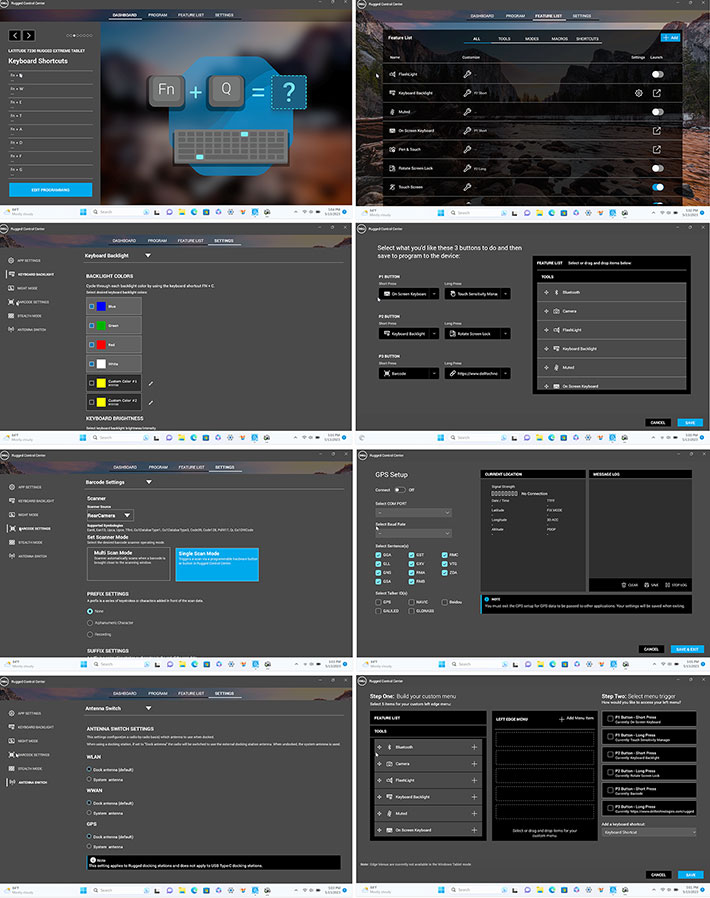
Also of note: the Dell Optimizer. It's like getting a checkup for your tablet, without having to resort to third party utilities that may or may not be legit. Support Assist makes sure you have the latest drives and downloads, scans the hardware for problems, cleans files, tunes performance, optimizes the network and nukes viruses and malware. It then logs a history so users have a record of how the system has been doing. SupportAssist also provides easy ways to contact an agent , submit files, and get online support.
Cameras: good enough for many jobs
The Latitude 7230 Rugged Extreme Tablet can be ordered with an optional integrated 5MP video front webcam with a hand-operated privacy shutter,  and also an 11MP (up from 8mp in the 7220) rear camera with LED flash that also has a manual privacy shutter. We used to doubt the need for such shutters, but no more. Privacy shutters are clever low-tech solutions to guard against the potential of unauthorized snooping via spyware or malware. and also an 11MP (up from 8mp in the 7220) rear camera with LED flash that also has a manual privacy shutter. We used to doubt the need for such shutters, but no more. Privacy shutters are clever low-tech solutions to guard against the potential of unauthorized snooping via spyware or malware.
Virtually every smartphone and tablet has front and rear cameras these days, so excluding them in rugged tablets would probably be considered a negative by many customers. Cameras directly integrated into tablets can be used to document work, and, of course, having a camera with a 12-inch screen elevates picture-taking into an entirely new realm.
Below is a compilation of sample pictures taken with the 7230's rear camera. Tap on the image collection to bring up a full size version in a separate window.

We are not generally fans of the standard Windows Camera app. It's just too basic and generic to take full advantage of integrated cameras. The one in our review 7230 was rev 2023.2302.14.0. For image resolution there are just two settings, 3840 x 2160 for 16:9 format, and 3648 x 2736 for 4:3 aspect ratio. No problem with that; the 7230 has plenty of storage space even for a large number of high-res images.
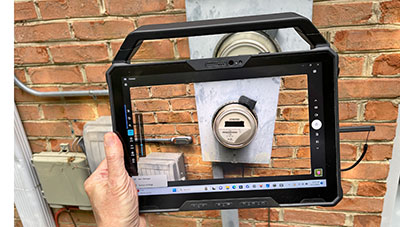 You can set a number of framing grids, you can set contrast, brightness, sharpness, saturation and privacy via the System camera settings, there's time lapse, and several flash settings. If you turn on "advanced controls" you get manual shutter and ISO control, exposure compensation, six white balance settings, timer, and digital zoom. There are several shooting modes: panorama, video, photo, document, whiteboard and barcode. The documentation camera also lets you get as close as four inches — good for sharp close-up details. You can set a number of framing grids, you can set contrast, brightness, sharpness, saturation and privacy via the System camera settings, there's time lapse, and several flash settings. If you turn on "advanced controls" you get manual shutter and ISO control, exposure compensation, six white balance settings, timer, and digital zoom. There are several shooting modes: panorama, video, photo, document, whiteboard and barcode. The documentation camera also lets you get as close as four inches — good for sharp close-up details.
For video, there are six resolutions, starting with 480p and going up to 2160p (which is pretty much 4k vide), all at 30 frames per second.
Bottomline here is that Dell gave the 7230 better cameras than most rugged systems have. That's good because today's users are spoiled by the excellent cameras built into smartphones and also by the sophisticated camera imaging apps that are available. As is, this tablet's cameras are good enough for many documentation tasks, and certainly good enough for very good quality conferencing.
Tough and rugged
Ruggedness and durability are sore subjects with consumer tablets where almost universally style prevails over substance. Largely because of that, Dell points out that the 5-year total cost of ownership of a rugged solution is actually only half that of a consumer product.
 As is, there are lots of options in the rugged tablet space. When Dell initially announced their Latitude-based rugged Tablet several years ago, a product manager pointed out that fully-rugged tablets tend to be heavy and quite expensive, while lower priced tablets didn't have the kind of features and performance that many prospective tablet users need. So Dell aimed in between and has pursued that approach ever since. As is, there are lots of options in the rugged tablet space. When Dell initially announced their Latitude-based rugged Tablet several years ago, a product manager pointed out that fully-rugged tablets tend to be heavy and quite expensive, while lower priced tablets didn't have the kind of features and performance that many prospective tablet users need. So Dell aimed in between and has pursued that approach ever since.
As a result, while the Latitude 7230 Rugged Extreme Tablet looks and feels solid and trust-inspiring, neither is a tank. Dell simply designed its rugged tablet to handle whatever hazards and conditions might be encountered in the real world.
Rugged tablets may be used in a wide range of temperatures, and so the Latitude 7230 Rugged Extreme Tablet can operate within an extremely wide temperature range of -20° to 145° Fahrenheit (-29° to 63°Centigrade), which means practically anywhere. .
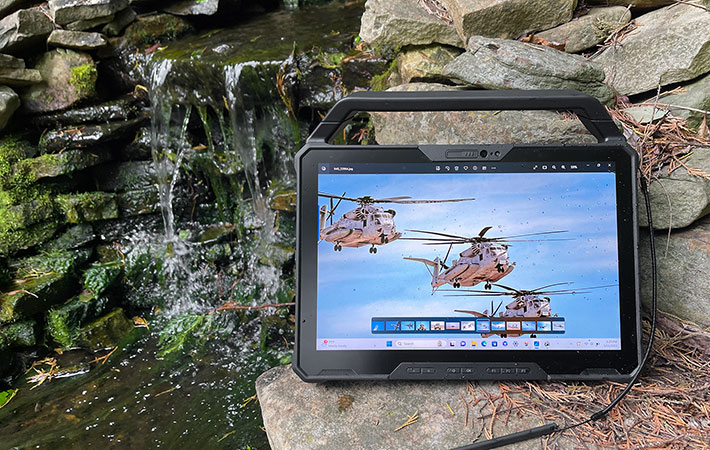
As for resistance to dust and liquids, the tablet carries an IP65 rating, where the "6" means the device is totally dust-proof, and the "5" that it can also handle low pressure water jets from all directions, albeit with "limited ingress permitted." Using the tablet in the rain is okay, spilling liquids on it is okay, but guard against submersion.
The images below were taken during a Dell media event a few years ago at Lake Travis outside of Austin, Texas. To show their faith in their tablets, Dell strapped a number of them, equipped with CartoPac course tracking software, onto jet skis and sent us tech journalists out on speedy, bumpy rides. No problem. The original tablets' 560 nit displays weren't quite as bright as we'd have liked; today's Latitude 7230 Rugged Extreme Tablet fixes that with its much brighter 1200 nits display.
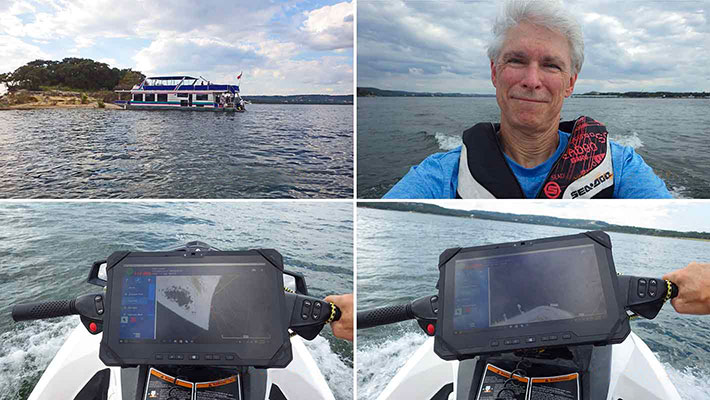
Drop tests were conducted in accordance with MIL-STD-810H. The 7230 passed the transit drop tests up to six feet, and 78 drops of single operating unit unit from three feet. That's impressive, but we like to see the ability to survive 4-foot drops while open and operating, because that is the height at which a laptop might be held while in a standing position.
Dell says the device is also independently tested according to MIL-STD-810G and the newer MIL-STD-810H procedures for transit drop, blowing rain, blowing dust and sand, vibration, functional shock, freeze/thaw cycles, and more.
Dell generally has ruggedness testing done by SGS United States and SGD Taiwan, SGS being one of the world's leading inspection, verification, testing and certification companies. Additional testing was done by the Taiwan and China locations of UL, a global independent safety science company. The images below were taken at a tour of Dell's own ruggedness testing facilities in Austin, Texas.
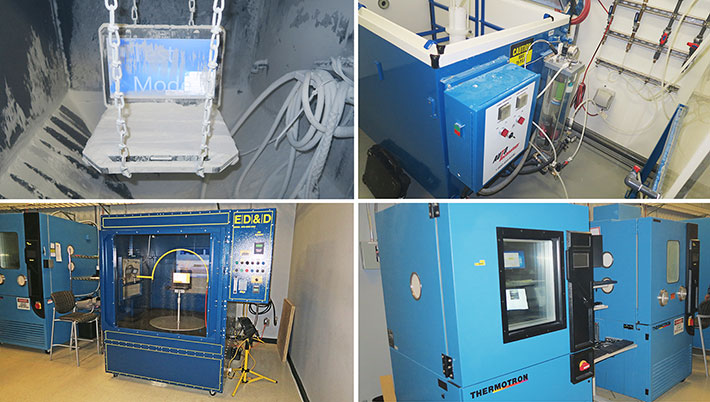
For use in hazardous locations, C1D2 certification is available. These are becoming more and more important, and they are a prerequisite for deployment in industries such as oil, gas, and petrochemical manufacturing, and many others where ignitable gases or vapor may be present.
Overall, the Latitude 7230 Rugged Extreme Tablet is just that, rugged. It's very well built, very sturdy, rubber bumpers provide good protection, and ports are well sealed with both plugs and sealing inside. That said, the emphasis here is on an intelligent balance of toughness and ease-of-use, not on heavy, vault-like invulnerability.
Summary: The Dell Latitude 7230 Rugged Extreme Tablet
Compared to Dell's overall sales volume, the market for rugged tablets is small and the competition from manufacturers focused on just rugged gear fierce. However, Dell is Dell and that name carries weight. Dell also allows customers one-stop shopping for all of their computing needs. So despite the frequent reshuffling of the small Dell rugged group and often lagging a bit behind in technology, Dell is definitely a Tier 1 contender in rugged systems.
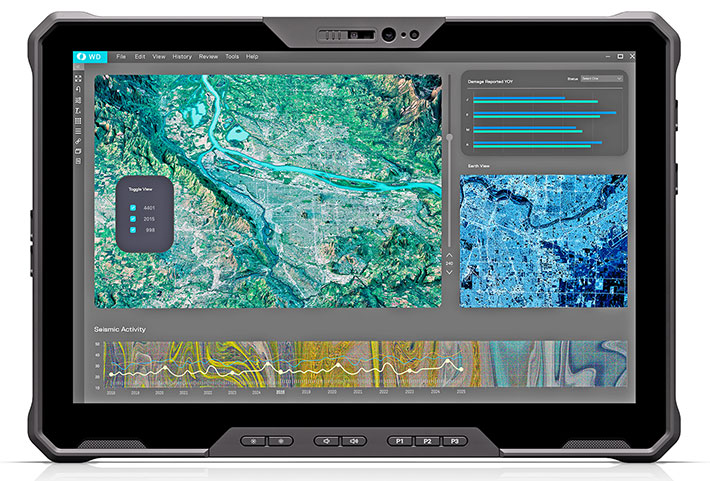
The Dell Latitude 7230 Rugged Extreme Tablet — all new compared to the predecessor 7220 — is for those who want an exceptionally well designed and executed tablet for tough jobs, and for which there is also a perfectly matched optional detachable keyboard.
Its semi-matte 12.0-inch 1920 x 1200 pixel display is very bright and offers superior reflection control, making it easy to use outdoors and even in direct sunlight. It also provides effortless multi-touch capability that works even with gloves on. The included narrow-tip capacitive stylus works well, and there is also an active pen option. With a weight as low as 2.8 pounds, the tablet is remarkably light and handy for a device this rugged.
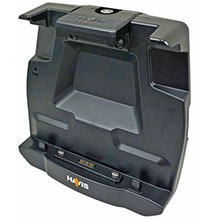 The Dell 7230 tablet covers connectivity basics (USB Type-A and dual Thunderbolt 4/Type-C, HDMI, Micro SD card, audio) and can also be configured with fingerprint and standard or contactless smart card readers. Additional connectivity (mini-serial, Fischer as well as barcode and magnetic stripe reading) is available via bolt-on modules. For on-the-road use, there's a Havis vehicle dock with additional connectivity, for the office a handy desk dock with dual battery charging.
The Dell 7230 tablet covers connectivity basics (USB Type-A and dual Thunderbolt 4/Type-C, HDMI, Micro SD card, audio) and can also be configured with fingerprint and standard or contactless smart card readers. Additional connectivity (mini-serial, Fischer as well as barcode and magnetic stripe reading) is available via bolt-on modules. For on-the-road use, there's a Havis vehicle dock with additional connectivity, for the office a handy desk dock with dual battery charging.
Available with a choice of three Intel 12th generation Core processors, the Dell Latitude 7230 Rugged Extreme Tablet combines very good performance with good power management, easily making full shift operation without battery recharging possible. Helping to achieve this high performance are very fast 5200MHz LPDDR5 RAM and PCIe NVMe solid state storage.
As the name implies, this is a rugged device designed to hold up to harsh conditions in the field. All ports have protective doors, there are fully integrated protective bumpers, the construction is very solid, and Dell provides comprehensive ruggedness testing data.
Overall, in our full review, the Dell Latitude 7230 Rugged Extreme Tablet convinced us as an elegant, very competent tablet solution with excellent performance and connectivity, very good expandability, and an excellent optional detachable keyboard that we highly recommend. – Conrad H. Blickenstorfer, May 2023
|
Dell Latitude 7230 Rugged Extreme Tablet Specifications
|
| Added/changed |
Full review 05/2023
|
| Type
|
Rugged tablet
|
| CPU
|
Intel 12th Gen Core i3-1210U, vPro, 6 cores/8 threads, up to 4.40GHz turbo
Intel 12th Gen Core i5-1240U, vPro, 10 cores/12 threads, up to 4.40GHz turbo
Intel 12th Gen Core i7-1260U, vPro, 10cores/12 threads, up to 4.70GHz turbo
|
| Thermal Design Power
|
All 9/29 watts
|
| OS
|
Windows 11 Pro, Windows 10 Pro
|
| Graphics
|
Core i3-1210U: Iris Xe with 96 graphics EUs
Core i5-1240U: Iris Xe with 80 graphics EUs
Core i7-1260U: Intel UHD Graphics
|
| Memory
|
Integrated 8GB, 16GB or 32GB 5200MHz LPDDR5 RAM
|
| Display
|
"Direct-View" outdoor-readable, anti-smudge, anti-glare, LED backlight, Corning Gorilla Glass 5 protective front glass, 1200 nits (1337 nits as tested)
|
| Display size and resolution
|
12.0-inch/1920 x 1200 pixel, 16:10 aspect ratio, 1200 nits luminance (1337 nits in our lab)
|
| Digitizer/Pens
|
Capacitive Water/glove-capable multi-touch; optional active pen
|
| Keyboard
|
Onscreen, optional external
|
| Storage
|
M.2 socket 256GB, 512GB, 1TB, or 2TB PCIe NVMe Solid State Drive
|
| Multimedia Pocket
|
None
|
| Slots
|
1 x microSD card, 1 nano SIM
|
| Housing
|
Est: Impact-resistant, flame-retardant, fiber-reinforced PC-GF50(40) polycarbonate
|
| Temperature
|
-20° to 145°F (-29° to 63°C)
|
| Humidity
|
MIL-STD-810H, Method 507.5, Procedure II, 10-90% noncondensing
|
| Vehicle vibration
|
ASTM D4169-04 (99), Schedule E, Truck Assurance Level II
|
| Salt Fog
|
MIL-STD-810H, Method 509.5, Procedure I (optional)
|
| Enclosure Class
|
IP65
|
| Altitude
|
MIL-STD-810H, Method 500.5, Procedure II (15,000 feet operating)
|
| Shock: Transit Drop
|
MIL-STD-810H transit drop (48")
|
| HazLoc
|
Optional: ANSI/ISA.12.12.01 certification capable (Class I, Division 2, Groups A, B, C, D)
|
| Certifications
|
See test report here (PDF).
|
| Size (inches)
|
11.65 x 8.0 x 0.94 inches (296 x 203 x 24 mm)
|
| Weight
|
Starting at 2.78 lbs. (1.26 kg); max. weight 3.5 lbs (1.59 kg)
|
| Power
|
2-cell 35.6Wh Li-Ion, optional second 2-cell 35.6Wh Li-Ion (hot-swappable with second battery)
|
| Cameras
|
Optional: 5MP RGB/VGA IR front webcam with privacy shutter, 11mp rear camera with privacy shutter and LED flash
|
| Scanning
|
Optional: 1D/2D barcode scanner
|
| Security
|
TPM 2.0 FIPS-140-2 and TCG certified, fingerprint reader, chassis and battery intrusion detection, lock slot; optional: Fingerprint reader, Contactless Smart Card reader
|
| Sensors
|
Accelerometer, ambient light, digital compass, gyro, lid, SAR
|
| Communication
|
Intel Wi-Fi 6E (2.4/5/6 GHz) AX211 2x2, 802.11ax with MIMO + Bluetooth 5.2 OR
Qualcomm® Wi-Fi 6E (2.4/5/6 GHz) WCN6856-DBS 2x2, 802.11ax with MIMO + Bluetooth 5.3
optional mobile broadband: Qualcomm Snapdragon X20 Global Gigabit LTE with/without eSIM OR Qualcomm Snapdragon X55 Global 5G with/without eSIM
|
| GPS
|
GPS: uBlox NEO-M9N, L1 (1575.42 MHz)
|
| Interface
|
2 x Thunderbolt4/USB 3.2 Gen 2 Type-C with Power Delivery
1 x Universal audio jack (UAJ)
1 x USB 3.2 Gen 1 Type-A port with PowerShare
optional expansion right: HDMI 2.0 OR USB 3.2 Gen 1 Type-A
optional expansion top: RJ-45 OR Fischer USB 3.2 and Mini-serial RS-232 OR 1D/2D barcode scanner
|
| Price
|
Inquire
|
| Website
|
Dell Latitude 7230 Rugged Extreme Tablet
|
| Ruggedness results
|
 Dell Latitude 7230 Rugged Extreme Tablet shopping Dell Latitude 7230 Rugged Extreme Tablet shopping
|
| Spec sheet
|
 Dell Latitude 7230 Rugged Extreme Tablet spec sheet Dell Latitude 7230 Rugged Extreme Tablet spec sheet
|
| Warranty
|
Standard 3-year mail-in service after remote diagnosis. Optional 3-5 year support, accidental damage, next-business-day
|
|
|




